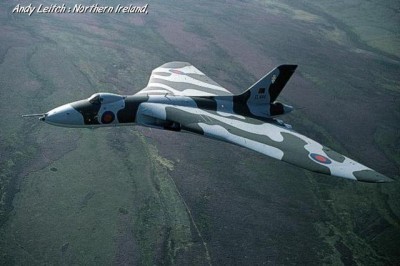|

Avro Vulcan

A post-WWII analysis of
Allied strategic bombing affirmed the success of such tactics during the
war. The new importance of nuclear weapons made it all the more imperative
that the world's nuclear powers have long-range delivery capabilities.
England's Royal Air Force (RAF) issued a requirement for a new aircraft
design which could be based anywhere in the world, be able to strike
targets up to 1,700 miles away, and deliver a heavy bomb load from high
speed and high altitude. One of the three finalists for the job was the
Avro Vulcan, first flown on 3 August 1952. The Vulcan's main distinctive
physical characteristic, its large delta-wing shape, was a result of the
need for structural integrity and a large payload capacity. To prove the
as-yet untested design, the Avro company built a series of one-third scale
aircraft, designated as Avro 707s.
The
first production model of the Vulcan, the B.Mk 1,
flew in early 1955, and after a few airframe and wing design changes,
entered service. While the first prototype Vulcans were powered by four
6,500-pound thrust Rolls-Royce Avon RA.3 engines, a series of engine
upgrades throughout its lifetime resulted in a final configuration of four
20,000-pound thrust Rolls-Royce Olympus 301s, giving the Vulcan
significant performance improvements over earlier marks.
Numerous other design improvements were gradually incorporated as well, as
follows: The B.Mk 1A variant incorporated a
modified tailcone housing an Electronic Counter-Measures (ECM) system. The
B.Mk 2 had more powerful engines than the B.Mk
1, a much-modified and larger wing, elevons for pitch and roll control
(instead of separate elevators and ailerons), an auxiliary power unit (APU),
in-flight refueling capability, and modified weapons-launch capability. In
the mid 1960s the B.Mk 2 was adapted as a long-range, low-level
conventional bomber. Finally, the SR.Mk 2
strategic reconnaissance variant appeared in 1973.
The
Vulcan remained on active duty with the RAF into the 1980s. Few retired
aircraft types retain the mystique enjoyed by the handful of remaining
examples of the Vulcan which have found their way into museums. For almost
a decade after its retirement, at least one Vulcan was flown at air
displays throughout Europe and the British Isles, but financial
considerations resulted in all Vulcans being grounded by the mid 1990s.
Nicknames:
Iron Overcast; The Tin Triangle
Specifications (B.Mk 2):
Engines: Four 20,000-pound thrust
Rolls-Royce Olympus 301 turbojets
Max Takeoff Weight: ~250,000 lbs.
Wing Span: 111ft. 0in.
Length: 99ft. 11in.
Height: 27ft. 2in.
Performance:
Maximum Speed: 645 mph
Ceiling: 65,000 ft.
Range: 4,600 miles with normal bomb-load
Armament: Up to 21,000 pounds of bombs, carried internally
Number Built:
134
Number Still Airworthy:
None |
